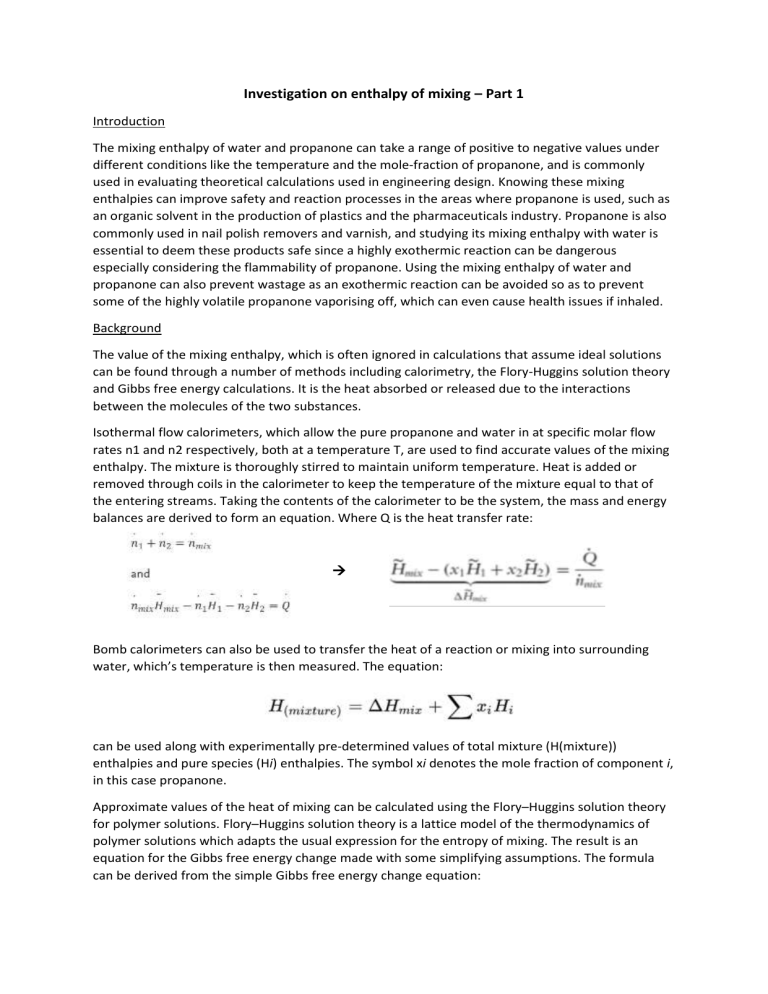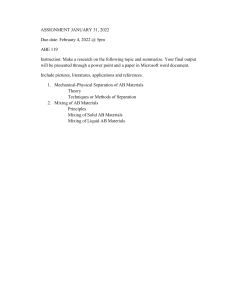
Investigation on enthalpy of mixing – Part 1 Introduction The mixing enthalpy of water and propanone can take a range of positive to negative values under different conditions like the temperature and the mole-fraction of propanone, and is commonly used in evaluating theoretical calculations used in engineering design. Knowing these mixing enthalpies can improve safety and reaction processes in the areas where propanone is used, such as an organic solvent in the production of plastics and the pharmaceuticals industry. Propanone is also commonly used in nail polish removers and varnish, and studying its mixing enthalpy with water is essential to deem these products safe since a highly exothermic reaction can be dangerous especially considering the flammability of propanone. Using the mixing enthalpy of water and propanone can also prevent wastage as an exothermic reaction can be avoided so as to prevent some of the highly volatile propanone vaporising off, which can even cause health issues if inhaled. Background The value of the mixing enthalpy, which is often ignored in calculations that assume ideal solutions can be found through a number of methods including calorimetry, the Flory-Huggins solution theory and Gibbs free energy calculations. It is the heat absorbed or released due to the interactions between the molecules of the two substances. Isothermal flow calorimeters, which allow the pure propanone and water in at specific molar flow rates n1 and n2 respectively, both at a temperature T, are used to find accurate values of the mixing enthalpy. The mixture is thoroughly stirred to maintain uniform temperature. Heat is added or removed through coils in the calorimeter to keep the temperature of the mixture equal to that of the entering streams. Taking the contents of the calorimeter to be the system, the mass and energy balances are derived to form an equation. Where Q is the heat transfer rate: Bomb calorimeters can also be used to transfer the heat of a reaction or mixing into surrounding water, which’s temperature is then measured. The equation: can be used along with experimentally pre-determined values of total mixture (H(mixture)) enthalpies and pure species (Hi) enthalpies. The symbol xi denotes the mole fraction of component i, in this case propanone. Approximate values of the heat of mixing can be calculated using the Flory–Huggins solution theory for polymer solutions. Flory–Huggins solution theory is a lattice model of the thermodynamics of polymer solutions which adapts the usual expression for the entropy of mixing. The result is an equation for the Gibbs free energy change made with some simplifying assumptions. The formula can be derived from the simple Gibbs free energy change equation: Explicit formulas for the enthalpy change of mixing (Delta Hm) and the entropy change of mixing (Delta Sm) were then found, leading to the formula: The right-hand side is a function of the number of moles (n1) and volume fraction (phi1) of fluid 1(water), the number of moles (n2) and volume fraction (phi2) of fluid 2(propanone), with the introduction of a parameter (chi) to take account of the energy of interspersing “polymer” and solvent molecules. R is the universal gas constant and T the absolute temperature. The Gibbs free energy of mixing can also be related to the enthalpy of mixing by the use of the Gibbs-Helmholtz equation, which shows the relationship between the two at constant pressure(rho): Other than these ways there are many more ways of calculating or finding out the enthalpy of mixing of water and propanone, but some methods are rather too complex and often experimental methods are the most accurate. Research question Investigate the effect of altering the temperature (283K, 298K, 313K, 328K, 345K) and the mole fraction of propanone (0.05, 0.1, 0.15, 0.2, 0.25, 0.3) on the mixing enthalpy of water and Propanone.


